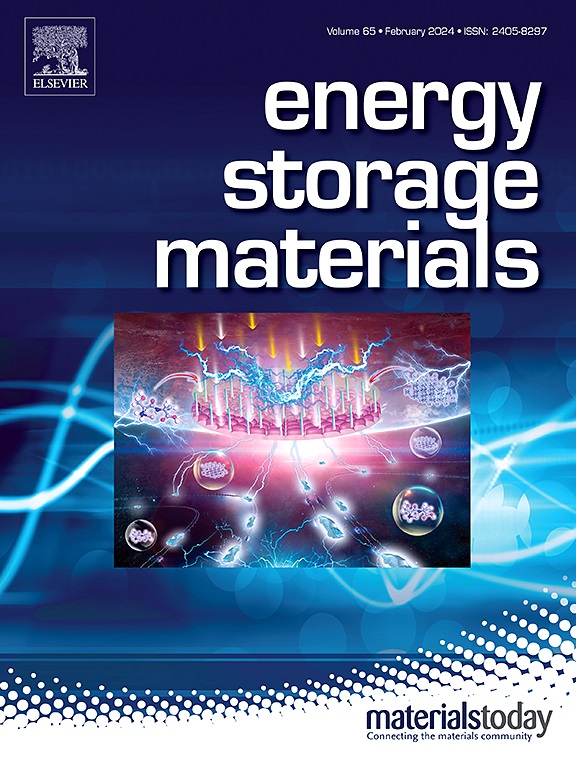Anode Materials for Lithium-Ion Capacitors: From Fundamental Mechanisms to Design Strategies
IF 18.9
1区 材料科学
Q1 CHEMISTRY, PHYSICAL
引用次数: 0
Abstract
Lithium-ion capacitors (LICs), which integrate battery-type anodes with supercapacitor-type cathodes, have emerged as promising energy storage devices by bridging the high energy density of batteries with the high power density of supercapacitors. However, their practical deployment remains hindered by inherent limitations in anode materials, particularly sluggish ion diffusion capability and inherent instability, which degrade energy efficiency and cycling stability under high-rate operation. This review critically examines the fundamental challenges and recent advancements in LIC anode engineering. We present a pioneering analysis of key performance bottlenecks, including kinetic and thermodynamic incompatibilities between Faradaic (battery-type) and capacitive charge storage mechanisms, with a focus on strategies to address sluggish charge/mass transport and structural/interface degradation. A systematic comparison of insertion-type, conversion-type, and alloy-type anodes, alongside emerging material candidates, elucidates how structural design, surface/interface modifications, and composite hybridization synergistically improve ion transport kinetics while mitigating mechanical degradation. Furthermore, we discuss critical challenges in designing next-generation LICs and highlight innovative tools to optimize energy-power trade-offs. By linking atomic-level material design to macroscopic device performance, this work outlines a roadmap for developing advanced LICs capable of meeting stringent grid-scale storage demands and accelerating the adoption of sustainable energy systems.

锂离子电容器负极材料:从基本机制到设计策略
锂离子电容器将电池型阳极与超级电容器型阴极集成在一起,将电池的高能量密度与超级电容器的高功率密度连接起来,成为一种很有前途的储能器件。然而,它们的实际部署仍然受到阳极材料固有局限性的阻碍,特别是缓慢的离子扩散能力和固有的不稳定性,这会降低高倍率运行下的能量效率和循环稳定性。这篇综述严格审查了LIC阳极工程的基本挑战和最新进展。我们提出了关键性能瓶颈的开创性分析,包括法拉第(电池类型)和电容式电荷存储机制之间的动力学和热力学不相容,重点是解决缓慢的电荷/质量传输和结构/界面退化的策略。通过对插入型、转换型和合金型阳极以及新兴候选材料的系统比较,阐明了结构设计、表面/界面修饰和复合杂化如何协同改善离子传输动力学,同时减轻机械降解。此外,我们讨论了设计下一代lic的关键挑战,并重点介绍了优化能源-电力权衡的创新工具。通过将原子级材料设计与宏观器件性能联系起来,这项工作概述了开发能够满足严格的电网规模存储需求并加速采用可持续能源系统的先进lic的路线图。
本文章由计算机程序翻译,如有差异,请以英文原文为准。
求助全文
约1分钟内获得全文
求助全文
来源期刊

Energy Storage Materials
Materials Science-General Materials Science
CiteScore
33.00
自引率
5.90%
发文量
652
审稿时长
27 days
期刊介绍:
Energy Storage Materials is a global interdisciplinary journal dedicated to sharing scientific and technological advancements in materials and devices for advanced energy storage and related energy conversion, such as in metal-O2 batteries. The journal features comprehensive research articles, including full papers and short communications, as well as authoritative feature articles and reviews by leading experts in the field.
Energy Storage Materials covers a wide range of topics, including the synthesis, fabrication, structure, properties, performance, and technological applications of energy storage materials. Additionally, the journal explores strategies, policies, and developments in the field of energy storage materials and devices for sustainable energy.
Published papers are selected based on their scientific and technological significance, their ability to provide valuable new knowledge, and their relevance to the international research community.
 求助内容:
求助内容: 应助结果提醒方式:
应助结果提醒方式:


